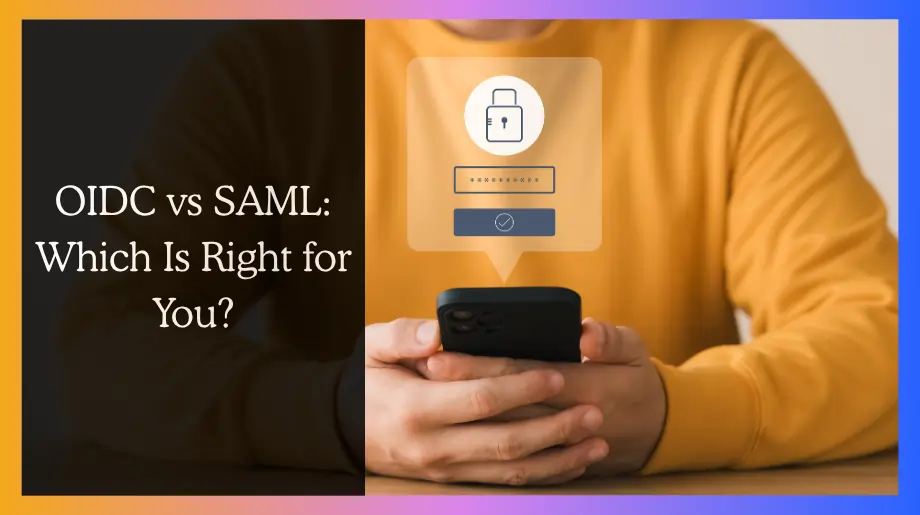Picking the right authentication protocol is business critical. Every millisecond of friction costs customers. Every security breach destroys shareholder value. Every month spent on complex integrations is a month competitors gain market share.
That's where the OIDC vs SAML debate begins.
OIDC emerged from the mobile-first, API-driven world where speed drives business outcomes. SAML was architected for the enterprise XML era when security teams controlled integration points.
Both solve authentication but optimize for different business realities. The wrong choice limits your ability to innovate, scale globally, and respond to market opportunities.
This guide breaks down key differences and trade-offs for your growth, security, and user experience decisions.
What Is SAML (Security Assertion Markup Language)?
SAML stands for Security Assertion Markup Language. It handles authentication for business apps. You use SAML to prove your identity across systems.
SAML works as a bridge between identity providers and apps. Your company stores user credentials in one place. SAML shares this data with other business tools safely.
This happens behind the scenes while users enjoy seamless single sign-on (SSO) access.
This XML-based protocol has secured business logins since 2005. Major companies rely on SAML 2.0 for critical systems.
Here are SAML’s core components that work together to protect your business:
- Identity Providers. Your central authentication hub that checks users
- Service Providers. Apps that trust your identity system
- XML Assertions. Encrypted proof of user identity and permissions
- SSO Flow. One login gives access to multiple business apps
What Is OIDC (OpenID Connect)?
OpenID Connect (OIDC) is the modern evolution of authentication protocols. It was built for today's web and mobile apps. OIDC sits on top of the OAuth 2.0 framework and uses JSON tokens.
OIDC uses lightweight JSON Web Tokens instead of heavy XML. It works with RESTful HTTP endpoints for clean authentication flows. This makes OIDC perfect for single-page apps, mobile apps, and API systems.
The difference between SAML and OIDC shows in OIDC's smart permission model. OIDC scopes control what user data apps can access. Users decide what information to share with each app.
OIDC's key strengths make it ideal for modern businesses:
- JSON Tokens. OIDC uses JSON tokens as small data packets. They carry your login info between apps.
- OAuth 2.0 Base. OIDC builds on OAuth 2.0 authorization rules. OAuth 2.0 already protects millions of apps.
- Mobile Ready. OIDC works well on phones and tablets. No special setup needed for mobile apps.
- User Control. OIDC lets users pick what data to share. They see clear options before giving personal info.
- API Friendly. OIDC helps developers add authentication easily. Modern apps connect with OIDC fast.
What are the Differences Between OIDC and SAML
Enterprise teams need clear guidance on protocol selection. OIDC and SAML serve different business needs. Your choice impacts development speed, security posture, and user experience across your organization.
Protocol Basis
OIDC and SAML use different core tech. This affects how your systems handle login data. Your tech team will see big differences in setup and care.
OIDC Foundation:
OIDC builds on the OAuth 2.0 authorization framework. OAuth 2.0 already secures millions of apps worldwide. This gives OIDC a proven base for modern authentication. The protocol uses REST APIs and HTTP methods. Developers find these tools familiar and easy to work with.
SAML Foundation:
SAML creates its own complete authentication system. It uses XML-based protocols for all security functions. SAML handles both authentication and authorization together. The protocol works through SOAP and HTTP POST bindings. This creates a full enterprise security framework.
OIDC leverages existing OAuth 2.0 rules and patterns. Teams who know OAuth 2.0 can learn OIDC quickly. SAML requires learning a completely new protocol system. Companies must train teams on SAML-specific methods and tools.
Setup Complexity
OIDC offers easier setup paths for your dev teams. SAML needs lots of setup and tech skills. Your choice affects project times and team needs.
Key setup factors impact your success:
- Setup Needs. OIDC needs basic HTTP redirects while SAML needs metadata exchange. SAML configs include public keys and endpoint URLs. Teams spend weeks on SAML setup. OIDC works with simple JSON responses
- Tech Skills. OIDC aligns with modern web ways that devs know. REST APIs and JSON feel natural to most teams. SAML needs XML experts and crypto knowledge. Finding SAML skills costs more money
- Deploy Time. OIDC setups deploy faster than SAML configs. You can test OIDC in days, not weeks. SAML projects take months to complete. Business apps launch sooner with OIDC
- OAuth Setup. Current OAuth systems extend easy to support OIDC. Many teams already use OAuth for APIs. Adding OIDC needs small code changes. SAML requires building new infrastructure
Security Features
Both protocols give big business security when you set them up right. SAML offers old, proven protection. OIDC gives modern security with easier setup ways.
Security points guide your protocol pick:
- Setup Errors. OIDC's simple JSON coding cuts config mistakes. Complex XML creates more bugs and gaps. Teams make fewer errors with OIDC. Simple systems stay more secure over time
- Proven Track. SAML has twenty years of security checks and docs. Government agencies trust SAML for critical data. Security experts know SAML attack patterns. Long history means stable protection
- Threat Protection. Both protocols kill password-based attack ways. Users don't type passwords into fake sites. Central login stops credential theft. Both block brute force attacks well
- Security Frame. OIDC builds on OAuth 2.0's documented security model. OAuth stops many common attack types. Token scopes limit data access risks. Modern crypto keeps OIDC tokens safe
Scale and Speed
OIDC gives better speed for modern apps. SAML works well for old big business systems. Your user feel depends on picking the right protocol for your setup.
Speed factors affect your user joy:
- Mobile Speed. OIDC handles resource limits better than SAML. Phones process JSON without battery drain. XML parsing kills mobile performance fast. Users abandon slow SAML mobile apps
- Processing Load. XML parsing makes delays in high-traffic places. Server CPU spikes with many SAML users. JSON processing stays light even with thousands of logins. Your hosting costs stay lower with OIDC
- Setup Support. OIDC works great with microservices and API systems. Cloud apps scale easy with OIDC tokens. SAML fits old server-based architectures better. Modern container systems prefer OIDC
- Token Check. OIDC's simple check improves response times. Apps verify tokens without complex lookups. SAML needs heavy XML validation steps. Users get faster access with OIDC
Use Cases
SAML serves complex big business places with compliance needs. OIDC shines for modern apps and fast dev cycles. Your business needs to decide the best pick.
Pick based on your specific company needs:
- Big Business Rules. SAML handles complex rule needs better. Government contracts often require SAML support. Banks and healthcare love SAML's detailed controls. Compliance teams trust SAML's proven track record
- Modern Dev. OIDC supports fast deploy and dev productivity. Startups ship products faster with OIDC. API-first companies choose OIDC every time. Agile teams prefer OIDC's simple setup
- Old System Setup. SAML works with the current XML processing setup. Enterprise systems already speak XML well. Legacy apps integrate easier with SAML. Migration costs stay lower with SAML
- Social Login. OIDC connects easy with consumer login providers. Google and Facebook use OIDC for login. Users expect social sign-in options today. Consumer apps need OIDC for growth
Mobile & API Ready
OIDC gets built for mobile-first places. SAML struggles with smartphone apps and API setups. Your mobile plan needs careful protocol thought.
Mobile skills decide user experience quality:
- Data Use. OIDC's light tokens cut mobile data use. Users save money on phone bills. Heavy XML messages cost more data. International users especially benefit from OIDC
- Battery Life. Simple processing saves device power vs XML parsing. Phones stay charged longer with OIDC. Complex SAML flows drain batteries fast. Users hate apps that kill their battery
- Deep Linking. OIDC supports native mobile app connection patterns. Apps launch other apps with secure tokens. SAML breaks mobile app switching flows. Users expect smooth app transitions today
- Token Refresh. OIDC gives simple ways for keeping login. Apps stay logged in without user hassle. Silent token updates work great on mobile. SAML forces users to login again often
Phishing & Brute Force Fight
Both protocols cut password-related security risks through central login. Setup quality matters more than protocol pick. Your security ways decide actual protection levels.
The SAML vs OIDC security comparison shows that security protection needs full approaches:
- Password Kill. Both protocols remove password-based attack surfaces. Hackers can't steal what doesn't exist. Users never type passwords into fake sites. Central auth blocks most common attacks
- MFA Setup. Multi-factor login strengthens either protocol. Phone codes and biometrics add extra layers. Both SAML and OIDC work with MFA systems. Security improves with any second factor
- Security Watch. Continuous watching spots unusual login patterns. AI systems detect strange behavior fast. Both protocols log all access attempts. Security teams catch threats before damage happens
- User Teaching. Training helps users spot and avoid phishing attempts. Educated users click fewer bad links. Security awareness programs work with any protocol. Human training beats technical fixes alone
When to Choose OIDC vs SAML?
The decision between these protocols should align with organizational requirements. It should match technical capabilities and strategic direction.
Your protocol choice shapes your entire digital strategy. Modern apps need fast setup and easy integration. Legacy systems require proven standards and complex features. Smart leaders pick protocols that match their business goals and tech stack.
Choose OIDC when your business priorities focus on speed and modern tech:
- Modern App Development. Building web apps, mobile apps, or single-page applications
- API-First Setup. Creating microservices or cloud-native systems that need fast integration
- Quick Deploy Needs. Launching products fast with simple developer tools and setup
- Consumer Apps. Supporting social logins from Google, Facebook, or other providers
- Cloud Systems. Working with modern cloud platforms and container setups
Select SAML when your organization needs enterprise-grade features and compliance:
- Regulated Industries. Meeting strict rules in banking, healthcare, or government sectors
- Enterprise Setup. Working with existing identity systems and complex user management
- Cross-Company Access. Managing federation between different organizations and partners
- Legacy App Support. Integrating with older systems that already use SAML protocols
- Complex Rules. Needing detailed user attributes and advanced permission controls
For complete identity management, many organizations adopt a hybrid approach. They support both protocols to accommodate diverse application requirements. This helps with different user populations too.
Is OIDC more secure than SAML?
The security comparison between OIDC and SAML doesn't yield a definitive winner. Both protocols can achieve equivalent security levels when properly implemented. The perception of superior security often correlates with implementation complexity and organizational expertise.
SAML's extensive feature set and XML-based architecture provide granular security controls. But it increases implementation complexity. This complexity can introduce security vulnerabilities. You need experienced security professionals to manage it properly.
OIDC's streamlined design aligns with OAuth 2.0 security best practices. This makes it less prone to implementation errors. The protocol's simplified token structure provides robust protection. It maintains developer accessibility at the same time.
Your security success depends on smart choices and good practices:
- Pick the right protocol. Choose what matches your team's skills
- Watch everything. Set up full security watching and record keeping
- Check often. Do regular security checks and find weak spots
- Stay current. Keep up with protocol updates and security news
- Layer protection. Use many security steps no matter which protocol
Your Next Steps in Identity Strategy
Successfully implementing authentication protocols requires careful planning.
Most companies make this choice once. Then they live with it for years. Your OIDC vs SAML decision shapes your entire authentication future.
This creates real stress for organizations. They worry about picking the wrong technology. They fear getting locked into one vendor solution. You need to pick what fits your business best.
OIDC and SAML both solve authentication needs. Each has different strengths for different situations. But you don't have to choose anymore.
Infisign removes this difficult choice completely. Our platform supports both OIDC and SAML together. You get flexibility without vendor lock-in.
Here's how Infisign handles your OIDC and SAML needs:
- Multiple Authentication Protocols. Native SAML, OIDC, and OAuth support without choosing sides or vendor lock-in
- Legacy Integration. SAMLfor enterprise, OIDC for modern apps, MPWA for legacy applications - one unified solution
- 6000+ Pre-built Integrations. Ready connections plus custom integrations for your specific tech stack
- MPWA Technology. Managed Password Authentication lets you use SSO with legacy apps that don't support modern protocols
- Unified Management. Single dashboard controls both SAML and OIDC authentications across your entire organization
- No Migration Stress. Keep existing SAML setups while adding OIDC for new applications seamlessly
- Cost Efficiency. One platform handles multiple protocols instead of buying separate vendor solutions
- Expert Implementation. Our team guides you through SAML and OIDC setup with proven best practices
Break free from authentication chaos with Infisign. A unified solution that’s fast to deploy, enterprise-ready, and built to scale with you.
Start your free Infisign demo and simplify authentication today.
FAQs
Is SSO using SAML or OIDC?
Single Sign-On works with both SAML and OIDC protocols. You can pick either one based on your needs. SAML fits enterprise environments and web-based SSO better. OIDC works great for modern apps, mobile systems, and API setups. Most smart organizations use both protocols together. This supports different application types across their business ecosystem.
Is SAML better than OAuth?
SAML and OAuth serve different purposes. SAML handles authentication and identity checks. OAuth manages authorization and access control. Organizations use both together. SAML verifies users. OAuth controls API access. Your choice depends on your needs. OIDC combines both by building authentication on OAuth 2.0.


















